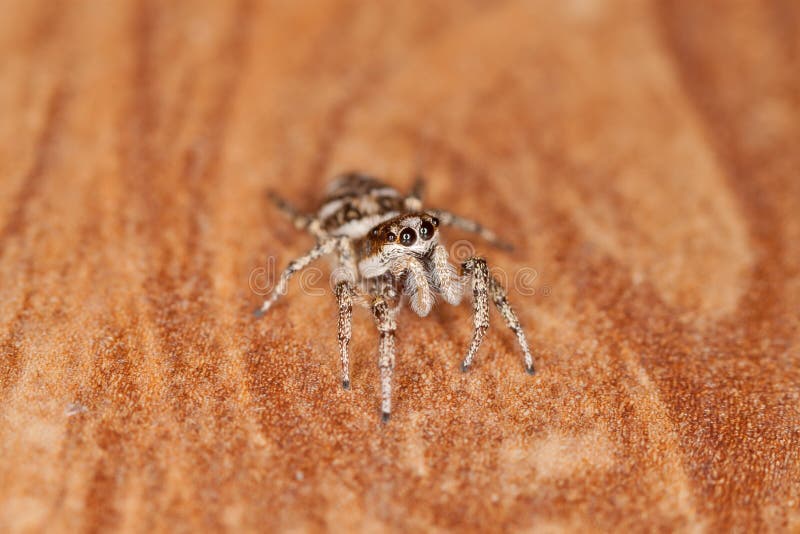

Spider from Tambopata River region of Peru. Cyclosa Reeves, I photographed this hard-to-find species while traveling to the Tambopata River region, Peru.

This defensive strategy confused predators into attacking the fake spider. This spider, which you can see at the top of this collection of dead insects, is a tiny arachnid that designs fake spiders. Photographed on a heliconia near El Valle de Anton, Panama.

I write about trying to identify this species. (Antrodiatetus pacificus), jumping or zebra spiders (the Phidippus with metallic fangs and Salticus scenicus), the writing spider (Argiope aurantia), the banded garden spider (Argiope trifasciata), and the cross spider (Araneus diadematus). Zebra spider (Salticus scenicus), a species of this genus, has many eyes facing forward to locate. More About Oregon Spiders: Hobo, Giant House, Black Widow, and Yellow Sac Spiders. Other Characteristic Features: The chelicerae of male spiders are long. Color: The spiders showcase a combination of black and white. Possibly picadus granulatus, photographed in El Valle de Anton, Panama. Size: Females spiders are 0.13-0.27 inches (0.33-0.68 cm) and males have an average size of 0.19 inches (0.48 cm). Photographed in the Tambopata region, Peru. Phoneutria genus, photographed on the Tambopata River, Peru. Photographed on Eagle Creek Trail, Columbia River Gorge, Oregon. Gasteracantha genus, photographed on Elbow Cay, Abaco, Bahamas. I photographed this Spiny-backed Orbweaver and wrote about it in my Bahamian Dry Forest journal. But if the spider is female, it may be gravid (ready to lay fertile eggs).
ZEBRA SPIDER OREGON FREE
This option is free and has limited ecological impact. They can be found in almost every environment, even in cities. Phidippus Johnsoni Red-Backed Jumping Spider The red-backed jumping spider, Phidippus johnsoni, is found throughout the Western United States and Canada. Photographed on the Osa Peninsula, Costa Rica. Since jumping spiders are common throughout the United States, it is easy to just capture a wild spider in warmer weather. The most common jumping spiders in Oregon are the zebra jumping spider, the daring jumping spider and the red-backed jumping spider. You see the little spider in the upper left of this photo? That's the male. Menemerus semilimbatus, Photographed in Naoussa, Paros, Greece This species walks across the surface of the water like a water bug. Photographed on the Dark Divide Trail, Washington. Photographed in Tualatin National Wildlife Refuge, Oregon. The black spider with its white spots, stripes, and short, stocky legs is often found in gardens and open habitats. Instead, they use their excellent vision to stalk and hunt prey. The small black and white zebra jumping spiders are typically harmless and don’t spin webs. Argiope appensa,Photographed on Kauai, Hawaii The zebra jumping spider measures 0.19 to 0.35 (5 9 mm) long. I used this photo of the large and beautiful Hawaiian Spider when writing about coral reef issues on the North Shore of Kauai. Unlike my other animal pages, I do not attempt to identify most spiders, and certainly appreciate identification help from anybody. Many species of arachnids require the help of experts to identify in the field. Symptoms of feeding injury from lygus bugs on potato plants.I was born with an innate fear of spiders, but slowly, I've learned to appreciate their fascinating beauty and diversity. They cause blackheart on celery, blasting on flower tissues, collapse of asparagus spears, decreased yields in carrot, beet, spinach, and other seed crops, etc. Lygus bugs can cause different types of damage to various growth stages of different crops. Host crops: Numerous different species of vegetables and other crops,Į.g., alfalfa, beet, cabbage, carrot, potato, spinach, Swiss chard,etc. Potato: Potato leafroll mosaic (Leafroll), Washington State University Hortsense Pacific Northwest Plant Disease Management Handbook: Potato ( Solanum tuberosum) – Aster Yellows Photo Source: Carrie Wohleb, WSU Extension Educator, Grant/Adams Counties Body length: 6-7mm Conservation status Common. Potato plant with a seed-borne infection of the aster yellows phytoplasma. Broccoli, cabbage, carrot, onion, potato, pumpkin, radish, shallot, spinach, squash, tomato, and more. Host crops: Over 300 kinds of plants, including a wide variety of vegetables. Vector: Aster leafhopper ( Macrosteles fascifrons) and other leafhoppers, and the phytoplasma can be carried in infected tubers Integrated Management of Storage Diseases, (Video Presentation), Focus on Potato, Plant Management Network International Their common name refers to their vivid black-and-white colouration, 1 whilst their scientific name derives from Salticus from the Latin for dancing, in reference to their agility, and the Greek scenicus, translating to. General Potato Disease and Pest Management The zebra jumping spider ( Salticus scenicus) is a common jumping spider of the Northern Hemisphere.


 0 kommentar(er)
0 kommentar(er)
